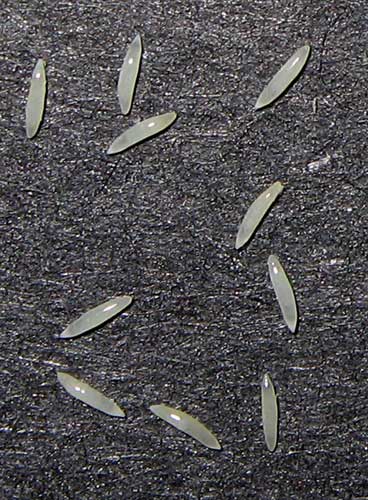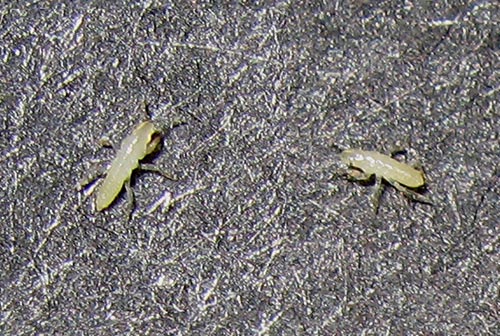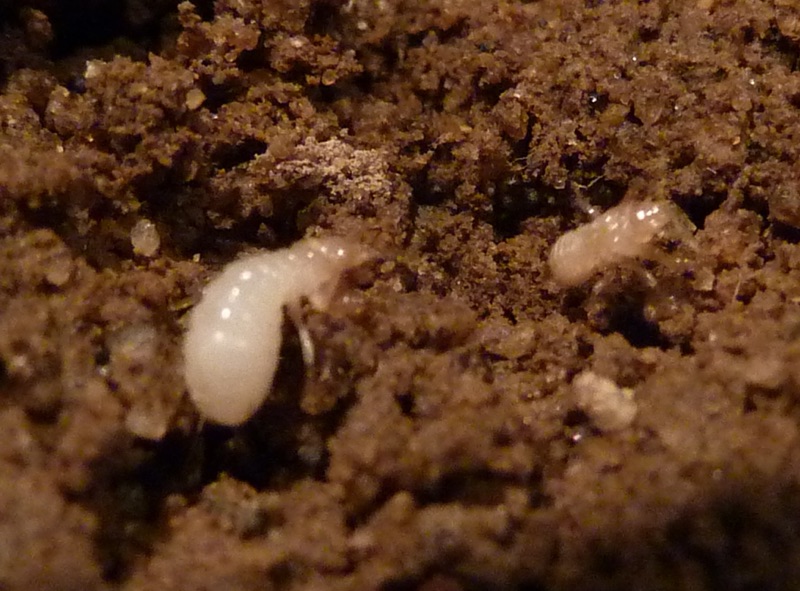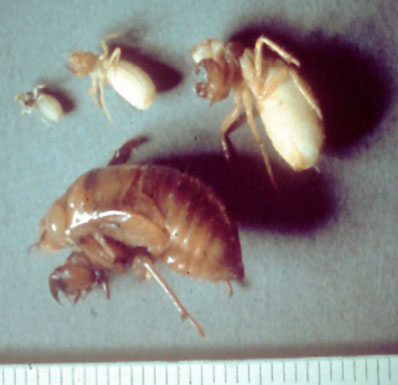So, what do cicada larvae look like? Technically they’re called nymphs, not larvae. When cicadas progress from one stage of development to another, they molt, rather than pupate. Each stage of development is called an instar. Most, if not all, cicadas go through five instars. The adult phase is the fifth instar.
First, here’s what their eggs look like:

Photo by Roy Troutman.
When the eggs hatch, the cicadas don’t look like a grub or maggot as you might expect; instead they look like tiny termites or ants, with 6 legs and antennae. At this point, they’re called first instar nymphs.
Here are some first instar cicadas:

Photo by Roy Troutman.
Here is a first and second instar cicada in the soil:

Photo by Elias Bonaros.
Here is a first, second, third, and fourth instar:

Photo courtesy of Chris Simon.
If you are interested in participating in cicada nymph research, visit The Simon Lab Nymph Tracking Project page for more information. You must have had periodical cicadas on your property in the past 13 or 17 years to find the nymphs — not including the Brood II area since those nymphs came out of the ground this year.
31 replies on “Cicada Larvae Pictures”
I have a real soft spot for cicadas from regularly going to Greece on holiday when my kids were very young, we would have loads of cicadas making in my opinion a fantastic noise in the trees outside our apartment, living in the U.K. we never had cicadas but we have since moved to the Sunshine Coast in Australia and I’m so pleased there are cicadas here, I even caught one on my walk home from work today on a fire trail through the bush, they don’t seem to fly away but instead just sit there in hope that you won’t see them, I gently picked it up, opened my hand and it sat there long enough for me to have look at it, then it flew off back into the bush,
I regularly sit by a small pond that’s full of fish and surrounded by all types of birds including kingfishers, fantails and many many cicadas, the sounds are just amazing, I close my eyes and the orchestra of birdsong and cicadas surround me, I love it 🙂
I too love the sound they make I’d be camping and I’d fall asleep to the sound and my little girl dog would to I’d have to keep her in a playpen so she wouldn’t eat them were about to get another invasion of them…I’m In the USA in Indiana
IDK about camping sights in range, but here’s some places where Brood III appeared last time:
Indiana locations: Crown Point, Portage, Purdue-North Central, Valparaiso, and more.
Indiana counties: LaPorte, Porter, Lake.
Hey! 7th grader here, and I keep cicadas as pets, I usually have them in a 20-gallon terrarium and have tree bark, plants, and bonsia trees in there with them, is there anything I can do to make it more like outside? and how long do they go underground, I’ve built an extra area that’s about 30 inches deep for them to burrow, are cicadas affectionate, I have one named Luna (Who is green and white) and she always sits on my shoulder when I take her to the outside area I have (Extra room that leads to outside but is a cube of mesh) and she won’t leave me, I mean it’s sweet but I had to make her a special cage that is RIGHT beside me when I sleep, I had to get a form filled out from my school so I could take her to school, she it usually very quiet, is that a problem? she will do her mini chainsaw thing at night, but that is it.
So interesting to read this. When I was a kid, there are a lot such cicadas in our neighborhood. Every summer after raining, there were quit a lot small holes around trees, we just need to open a little bit that tiny hole, the small worms will run out. We used to collect them and then fried them for dinner, very delicious. After all, next day, there were still a lot fresh cicadas climbing on the tree and singing around. Years later, all trees were cut and neighborhood bekam industry area,I never saw such creatures any more. Only the splendid memories left, it was over 45 years ago after all.
I’m living under a hug tree and the roots practically grow under my house . I have some sort of larvae and nymphs of some critter but when i do Google lens I get a different suggestion every time. Are they in every state in the USA? I live in the mountains of North Carolina at highest peek east of the Mississippi ? Also do they lay dormant during the winter months? I’m fascinated by bugs of all sorts and determined to study all critters small I have conquered the large animals now to the smallest. Thank you
I’m on the coastal area of Galveston, Texas and we have cicadas everywhere. This morning I found one laying in the middle of covered walkway, belly up and freshly hatched. How long does it usually take before they’re able to fly away??
Here in China. Today, we found a live cicada nymph in a fresh water stream. I pulled him out hoping to save him. Popped him on the bank at the waters edge and he quickly made his way back into the water and disappeared. Are there fresh water nymph varieties?
The poor creature was probably confused.
It might have been a different variety of nymph that is aquatic pre-adulthood, perhaps something in the odonata family?
Maybe a dragonfly nymph?
Hello,
Thanks for the great photos and info. I am an entomologist in South Africa studying our biggest species found here, but no one knows much about how long it takes for the eggs to hatch? (actually no one knows much about these guys at all). I was wondering how long it took for your eggs to hatch? I know they are different species but any baseline would be helpful.
Thank you so so much
It depends on the species. For our smaller periodical species in 1-2 months. Our larger species can take longer, and some I’ve heard do not hatch until the following spring. I’ll see if I can find a paper that talks about this.
How do I encourage cicada larvae into my garden? Currently i have none, but they r a local specie. I am in suburbia in Miami Queensland Aus, i have yellow penda,ivory curl,red gum, bottlebrush, butterflies, dragonflies, green tree frog, but no cicadas. I would love to introduce to my little microclimate xx
Plant trees that they like. Walk around your neighborhood and local parks and observe which trees the cicadas prefer and then plant those in your garden.
Hi Dan,
I understand that the periodical nymph molts several times underground (four?) alone in its little cavern. What happens to the castoff shell or skin? Does the cicada reusue it in some way? or does it just decay?
thanks!
I haven’t read that the cicadas use the shed chitin in any way, so it likely decays and mixes with the soil. I’m not sure what breaks it down, but probably the usual suspects like fungi, bacteria, and other decomposers.
I’m still unsure about the process. The cicada nymphs, which fall to the ground below the tree where the eggs were laid, then burrow into the ground at that spot? they look like white ants? Is that correct? I have seen the holes that the cicadas burrowed out of this year, and they aren’t always near a tree? Does this mean that the nymph ‘ants’ crawl for a bit before they dig into the ground. Why don’t we see them doing this, is it b/c they are too small?
I have so enjoyed the Brood this year in the woods next to my home in e. tennessee mtns. I can hear them begin in the morning and when I open the door it is an instant link to Nature, and wonderful distraction. They are now subsiding quickly. I will miss them.
They are incredibly small. Less than a quarter of an inch and nearly translucent. Because they’re so small and light they can be carried by the wind. Floating more than falling to the ground. Cicadas don’t stay where they land and the first burrow — they tunnel throughout their 17 years underground, which explains why you don’t see them emerge where you think you might. Tree roots often spread out well past the canopy of the tree, so cicadas can emerge a long way from the tree trunk.
What happens to the nymphs if the tree (whose roots they’re feeding on) dies?
Mostly they die unless they’re able to tunnel to the roots of another tree.
while straining my compost I came across white plastic looking larva or eggs about one inch flat no legs or heads I am assuming they were eggs they were so tough I could hard destroy them I had to chop them up. Are they cicada eggs? Thanks Alma
No.
You won’t find cicada eggs in the soil. First, they’re very tiny — less than 1/4 of an inch long and transparent. Second, the female cicada deposits the eggs in a groove she makes in branches the same year she mates. They hatch that same year and basically look like tiny white ants.
My ears are super sensitive. One cicada will almost drive me batty. I’m in northwest Florida. Panhandle. Very close to South Georgia. My new trick. Super power Waterhouse and I spray the tops of my oak trees. Do you hear that. Crickets… LOL
Howdy from Georgia. We have had cicades for 16 years. So many and so loud it effects our sleep and peace and quiet. Between the whippoorwill that decided to live in my back yard and the cicades…..-sleepless in Georgia
Hello,
I have had 3 cicadas appear in the last 2 nights, in SW Michigan.
I have not seen one since we were chased out of the Brookfield Zoo in Chicago IL because of a 17 yr hatching when I was much younger, possibly 1987 or around then. The trees were pulsing with layers of these flying things! There had to be millions of them. Was I witness to a certain ‘brood’?
I tend to do pest control here, but don’t recall ever seeing these holes or the crusts of the 4th stage of life, or seeing these huge flying parasites here before. I was looking for information on how many larvae each cicada might lay, and if you have information on this area, what might we expect from this hatching? We have several dying trees around our patio, but I have only found these 3 up close to the house next to the patio. Should we protect the trees we want to keep, and if so, how?
Cicadas are not parasites they have no mouth and if anything they are the food that feed larger insects and animals!!
Technically, they’re plant parasites.
hi! i love this site! cicadas fascinate me, but i thought i was the only one!! thank you!!!
I posted a PDF on the homepage which can be used for coloring.
Great site! However, I’m looking for simple illustrations I can give to kids to color. I have a good info sheet but
I thought a coloring page (especially for the young ones) might make them seem a little more familiar.